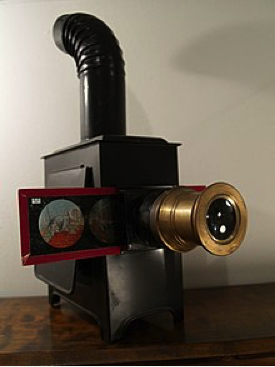Before television and cinema, a magic lantern projector was used with hand-painted glass slides. Because the lens inverts the image the slides had to be inserted upside down and back to front. It was for entertainment purposes and in wide use from the 18th century until the mid-20th century. It was superseded by the 35 mm photographic film slide and became know as the slide projector.

A page of Willem 's Gravesande's 1720 book Physices Elementa Mathematica shows Jan van Musschenbroek's magic lantern projecting a monster. The lantern is one of the oldest known. It used a concave mirror behind a light source to direct the light through a small rectangular sheet of glass, a "lantern slide". Originally the pictures were hand painted on glass slides. Many slides were finished with a layer of transparent lacquer but later on cover glasses were used to protect the painted layer. Some slides were mounted in wood frames and after 1820 were rimmed with a strip of glued paper. Apart from sunlight, the only light sources available at the time of invention were candles and oil lamps. The invention of the Argand lamp in the 1790s helped to make the images brighter. The invention of limelight in the 1820s made them even brighter. It was followed by the bright electric arc lamps in the 1860s and eliminated the need for combustible gases or hazardous chemicals. Eventually the incandescent electric lamp further improved safety and convenience.

These slides show ‘Captain Hook’ as a pirate. He is a fictional character and the main antagonist of J. M. Barrie's 1904 play Peter Pan; or, the Boy Who Wouldn't Grow Up. He is Pan’s archenemy. Hook is captain of the brig Jolly Roger. His two fears are the sight of his own blood and the crocodile that pursues him after eating the hand cut off by Pan. An iron hook replaced his severed hand, which gave the pirate his name.

Hook did not appear in early drafts of the play, wherein the capricious and coercive Peter Pan was closest to a "villain", but was created for a front-cloth scene, flown downstage, in front of which short scenes are played while big scene changes are "silently" carried out upstage. Later, Barrie expanded the scene, on the premise that children were fascinated by pirates, and thus the role of Hook the captain developed. According to A. N. Wilson, Barrie "openly acknowledged that Hook and his obsession with the crocodile was an English version of Ahab. Ahab is in the Hebrew Bible and presented as a wicked king. The existence of Ahab is historically supported outside the Bible, as he became king of Israel from 869 to 850BC.